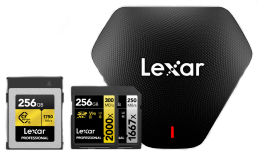
When searching for a USB (Universal Serial Bus) memory device, you might find a number following “USB.” This number contains information regarding the generation and the transfer speed of the device. The memory and storage experts at Lexar are here to share a closer look.
An Overview of USB 3.0
USB 3.0 (or SuperSpeed USB), the third generation of USB ports, were released in 2008—all USB numbers beginning with the number three fall within this generation. SuperSpeed USB ports can transfer data at a rate of 5 Gbit/s (gigabits per second)—10 times faster than the former USB 2.0 Hi-Speed devices. Because the new USB has been slightly altered since 2008, the name has also been revamped. USB 3.0 is considered equivalent to USB 3.2 Gen 1.
A Guide to USB 3.1
On July 31st, 2013, USB 3.1 (also called USB 3.2 Gen 2 and SuperSpeed+) replaced USB 3.0 as the standard. These USB devices are twice as fast, with a 10 gigabits per second data transfer rate. Additionally, the USB 3.1 update marked a widespread uptake of the USB-C port type. As a result, you can commonly find both standard and type-C USB 3.1 and later devices.
USB 3.2 Gen 2×2
On July 25th, 2013 USB 3.2 standards were released, introducing the fastest USB currently on the market. The USB 3.2 Gen 2×2 offers data transfer at 20 gigabits per second—twice as fast as the USB 3.1. This technology is only supported by USB Type-C connectors. USB 3.2 Gen 2×2 works by simultaneously running two “lanes” of 10 Gbit/s data transfer.
How Do USB Devices Differ?
As mentioned above, the biggest difference between the USB generations is the transfer speeds. In a professional setting, the transfer speed can make a big difference in the time it takes to send files and move your work forward. However, when working with a low volume of data, you might not even notice the difference in speeds.
Your priority in choosing a USB storage drive is to find one that is compatible with your device. Particularly, make sure you pay close attention to whether you need a rectangular USB type-A or a rounded USB type-C drive. Other considerations include the capacity of your drive (how much data can it store?) and the transfer speed (how much data will you typically transfer?). Collectively, these considerations will inform which USB device will best meet your needs. For professional use, you might consider buying a USB 3.1 or later device for quick transfers that can accelerate your workflow.
Lexar Memory Solutions
Lexar offers fast and reliable USB drives for every purpose—including photography, videography, computer storage, and file transfer. You can learn more about how Lexar memory products are trusted by professional photographers and ambassadors in our community.
Our USBs are rigorously tested in our Quality Labs to ensure trusted compatibility with a comprehensive variety of computers and devices. You can find a Lexar retailer near you to get the high-quality memory products you need today!




